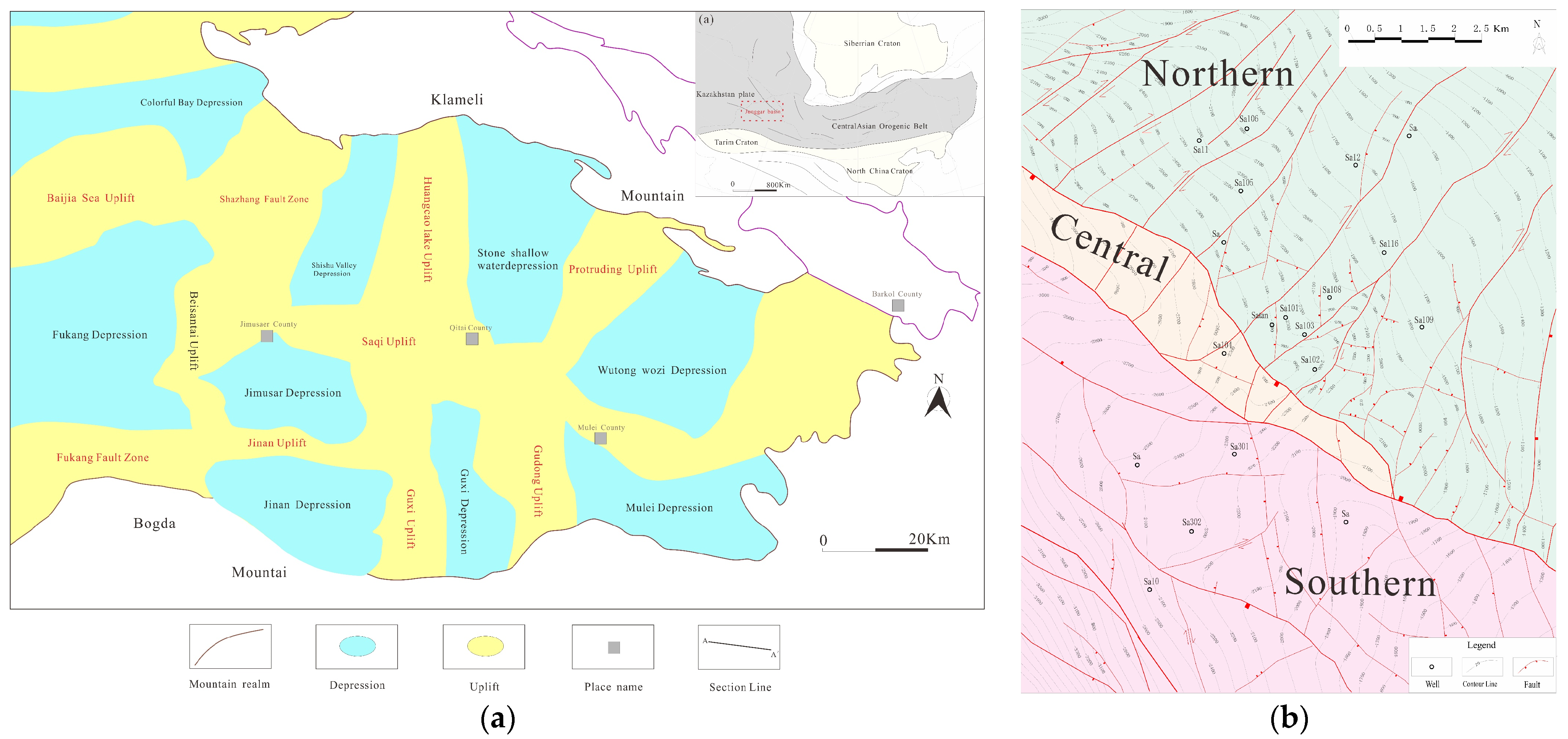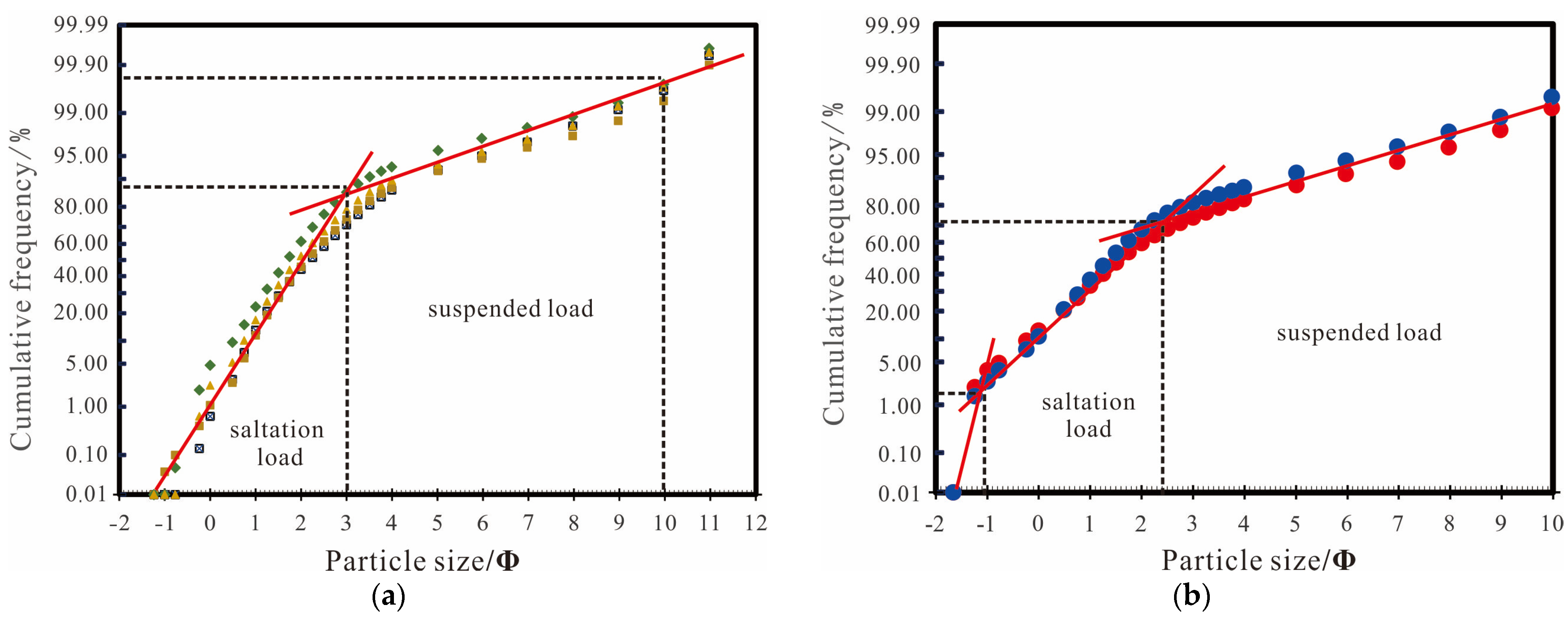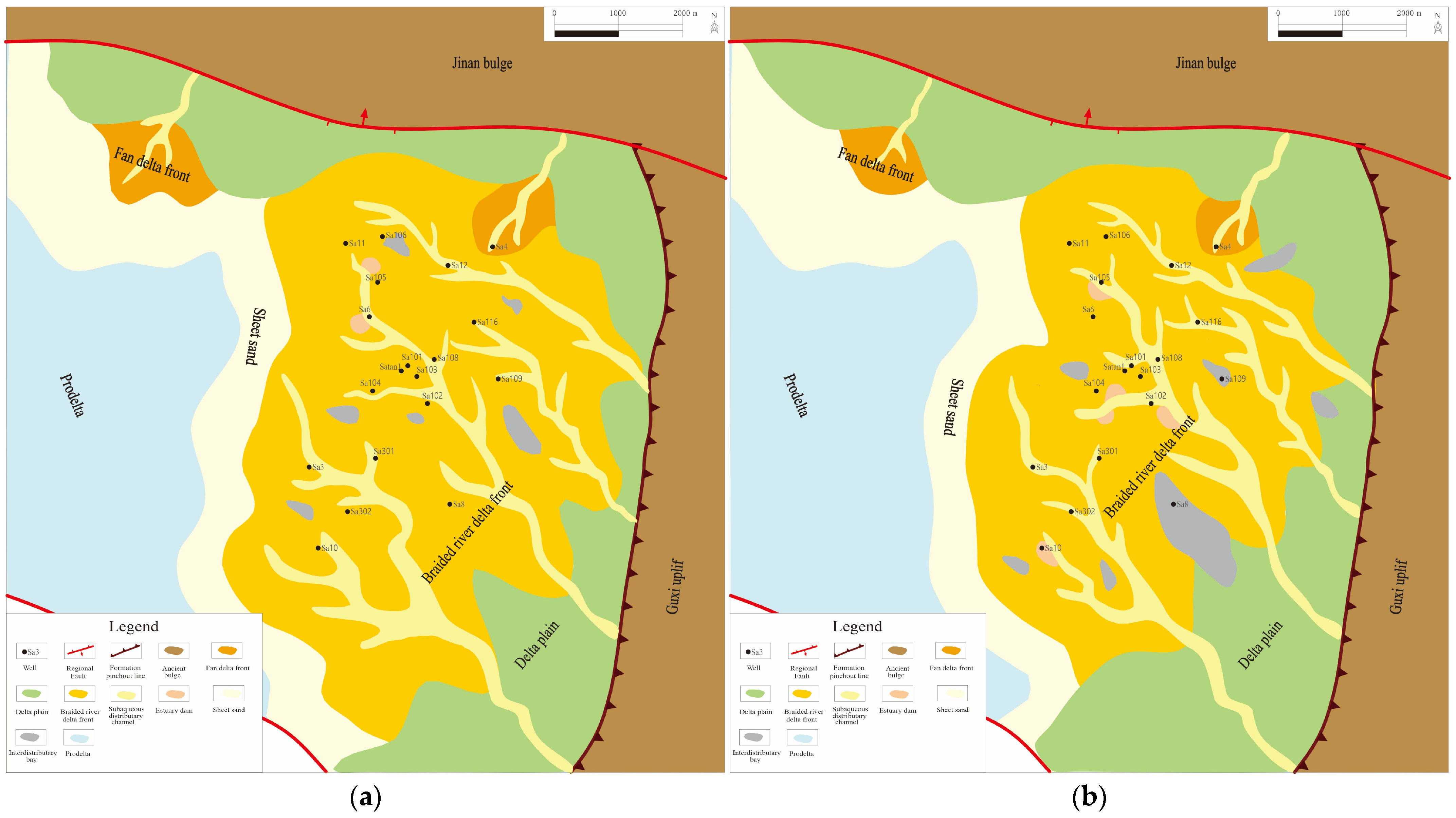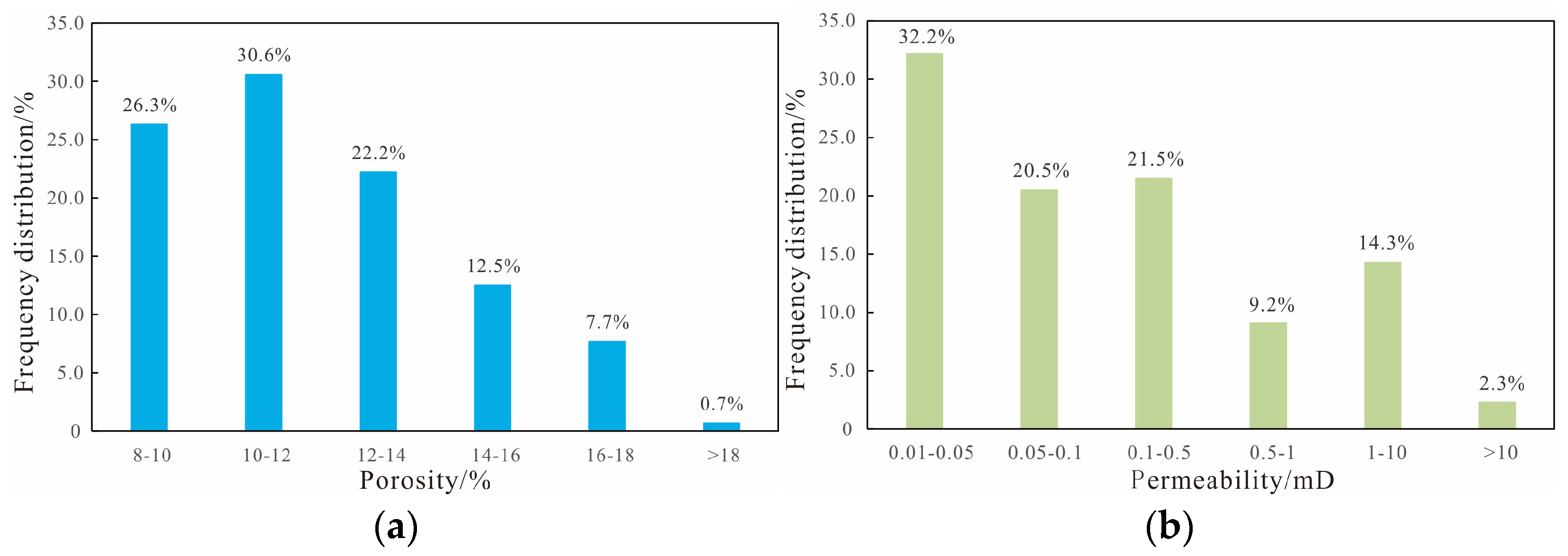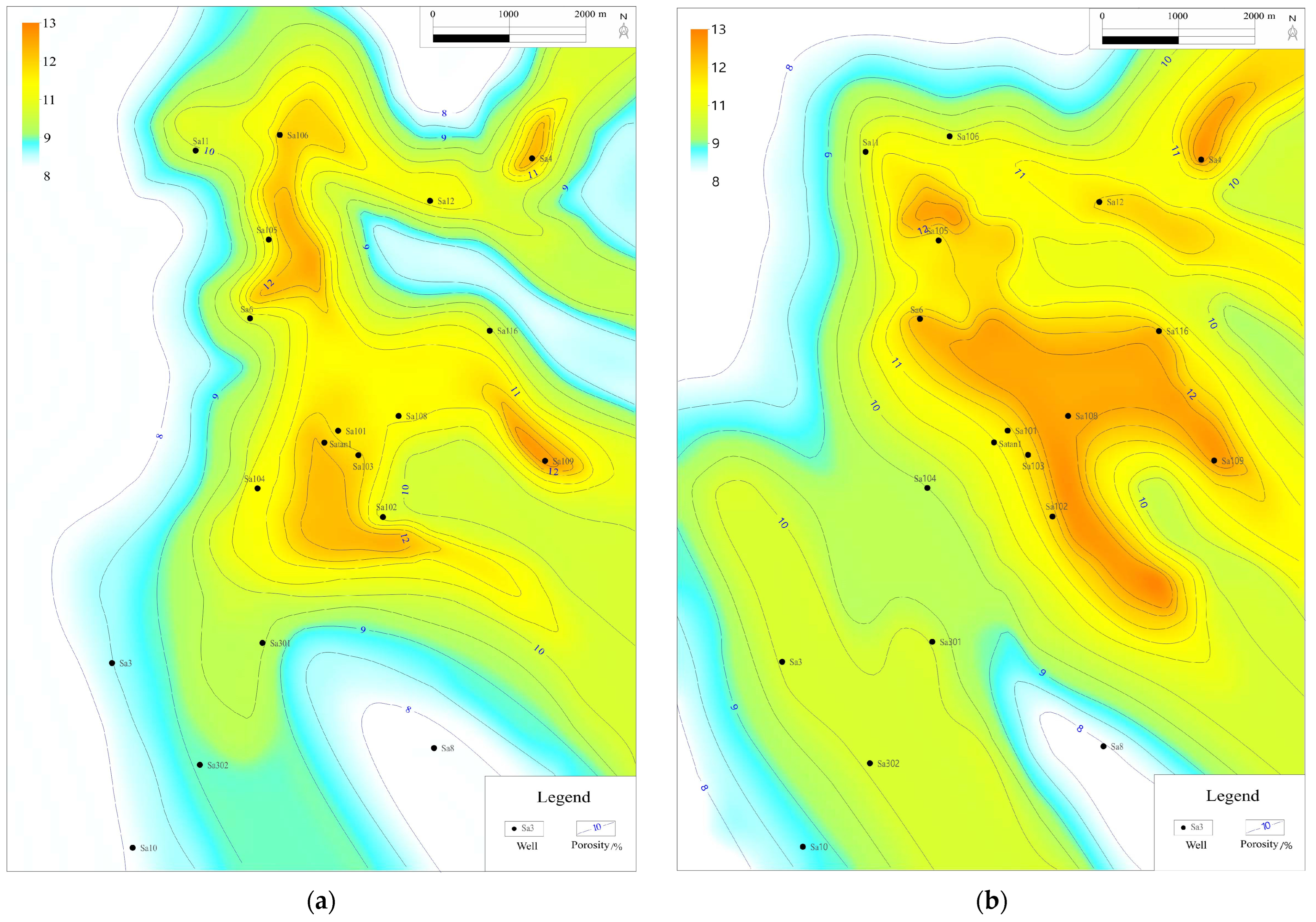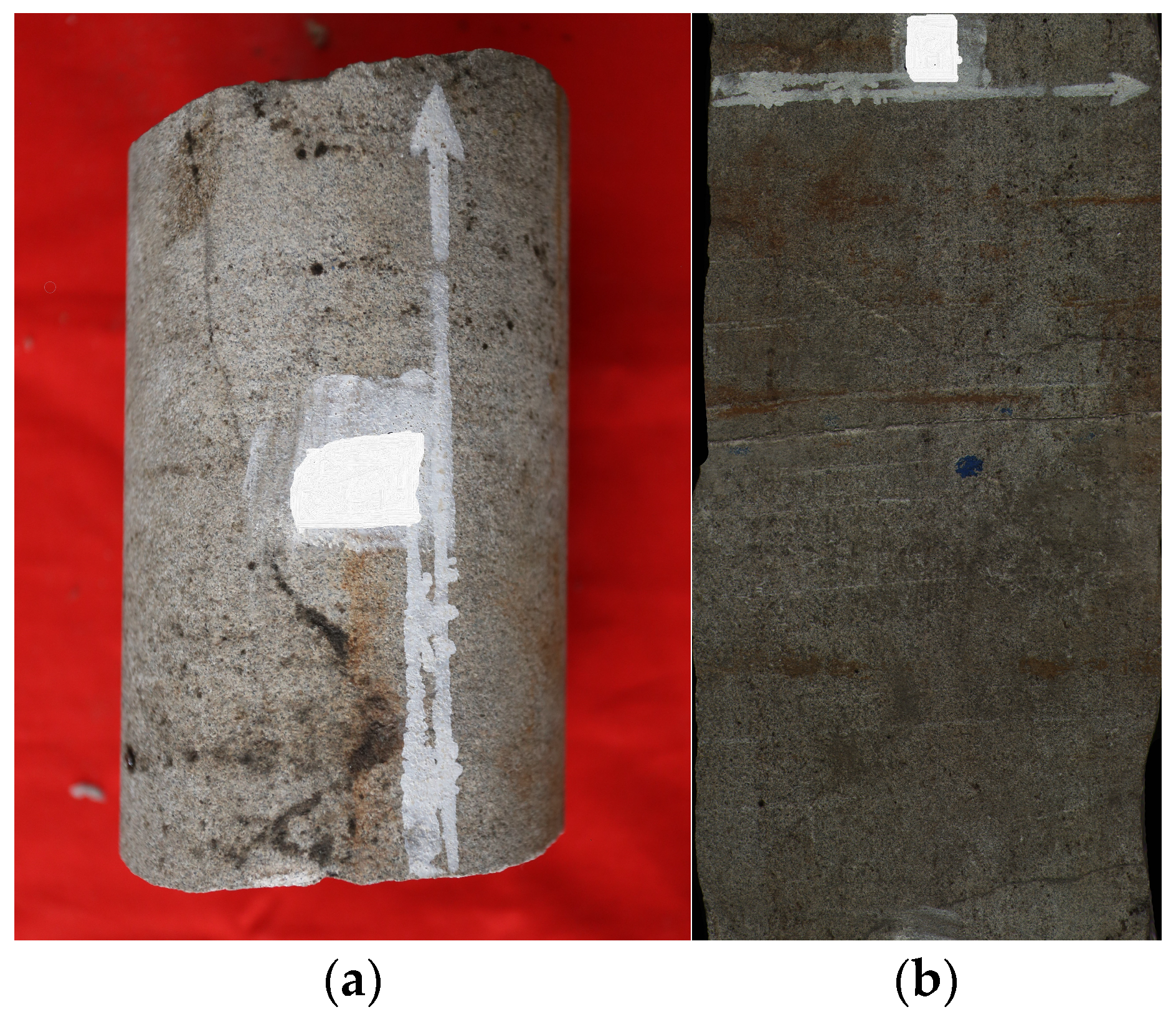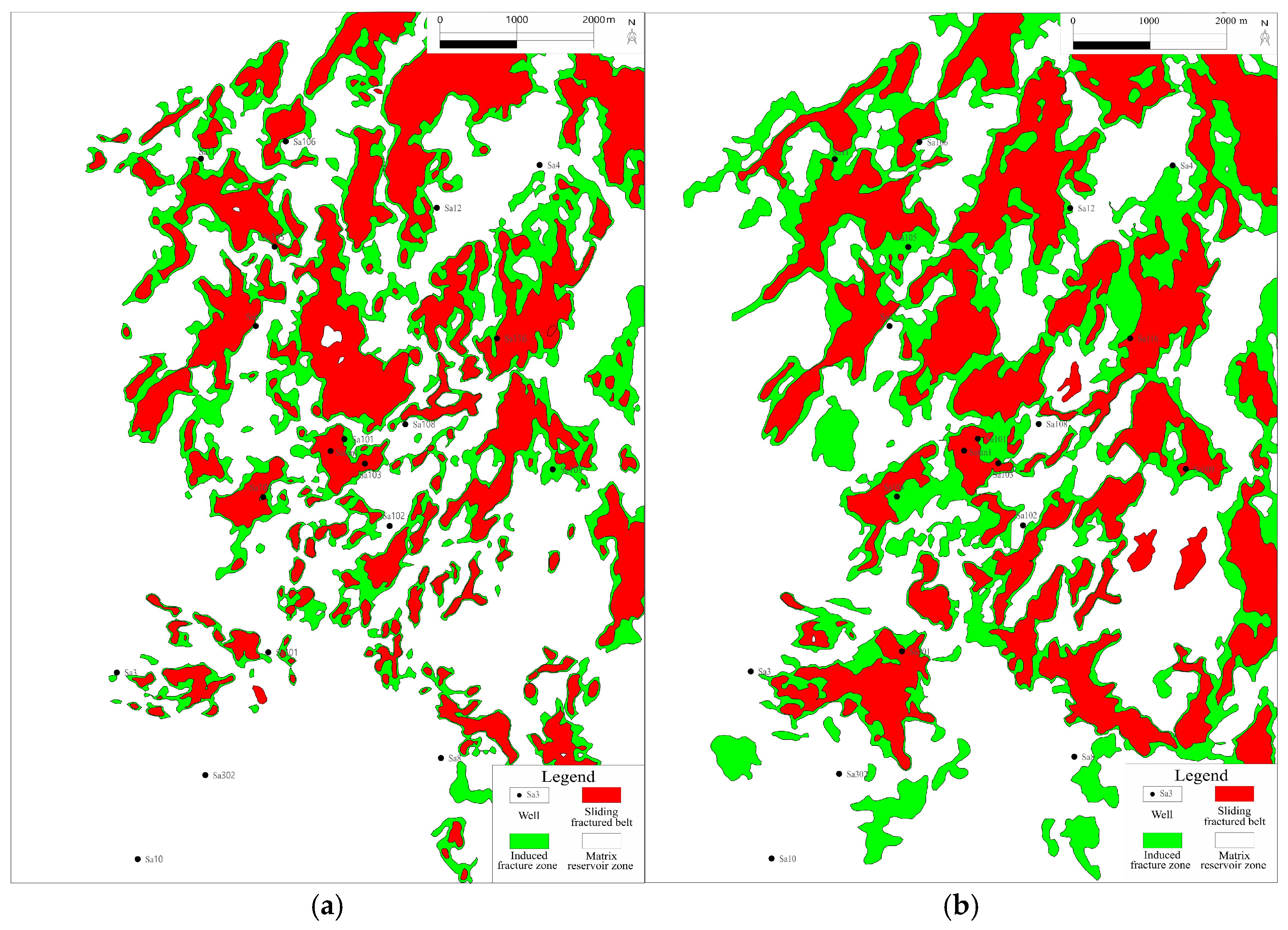1. Introduction
The continuous growth of global oil and gas demand and the gradual depletion of conventional resources have highlighted the crucial importance of unconventional resources. Tight oil reservoirs represent a pivotal resource category, playing a crucial role in safeguarding the energy supply of the future. In recent years, China has made significant breakthroughs in tight oil exploration, with the Xinjiang Junggar Basin being an important enrichment area, possessing abundant tight oil resources. Multiple sags within the basin have promising prospects for forming an integrated oil and gas system [
1,
2]. The Mahu Oilfield was discovered under the theory of reservoir formation in the sag area [
3]. Additionally, high-yield oil reservoirs were discovered in the Permian System of the Jinnan sag in the Junggar Basin, with the Satan 1 and Sa 4 blocks mainly being structural–lithologic oil reservoirs [
4]. The Jinan sag has been shown to possess enormous exploration potential, as evidenced by a significant breakthrough made by the Satan 1 well. The Junggar Basin’s tight oil reservoirs are still being explored and developed; further in-depth studies on their characteristics are required to effectively guide operations and enhance recovery efficiency [
5]. Especially in the Jinan sag, the tight reservoirs of the Jingjingzigou Formation have strong heterogeneity, and the distribution and enrichment patterns of high-quality reservoirs need to be clarified [
6,
7].
To achieve more accurate characterization of tight reservoirs, researchers at home and abroad are increasingly relying on machine learning (ML) techniques to improve prediction accuracy. Eriavbe et al. used ML technology to predict permeability, employing a deep normalization method and combining artificial neural networks (ANNs) to train core and logging data, obtaining more realistic prediction results and enhancing reservoir characterization levels [
8]. Tang et al. proposed an integrated machine learning framework, combining gradient-boosting decision trees (XGBoost, CatBoost, LightGBM) and generative adversarial networks (GANs), and automatically identifying shale reservoir sweet spots based on logging data, showing higher accuracy [
9]. Yuan et al. used support vector regression (SVR) to establish nonlinear relationships between reservoir parameters and various attributes, demonstrating high accuracy and resolution in predicting shale brittleness parameters [
10]. Ore et al. utilized supervised ML algorithms to predict the brittleness of unconventional reservoirs based on logging and seismic attributes [
11]. Zhu et al. compared the performance of unsupervised ML methods in predicting gas saturation, porosity, and depositional facies using multiple seismic attributes [
12]. Anifowose et al. attempted to predict rock porosity from advanced mud gas (AMG) data using ML and found that the random forest (RF) model performed better than the artificial neural network (ANN) and decision tree (DT) models [
13]. Moussa et al. used big data methods, using support vector machines (SVMs) to predict permeability, fuzzy clustering to evaluate fracturability, hierarchical clustering for lithology classification, and 3D Kriging interpolation to construct a high-resolution rock physics model, introducing the reservoir quality index (RQI) for sweet spot identification [
14]. In China, Cao et al. and Zhang et al. have used machine learning methods to identify diagenetic facies and lithology, which have become effective means to improve reservoir evaluation accuracy [
15,
16].
Furthermore, by integrating studies on tight reservoirs, natural fractures, and artificial fractures, scholars have utilized ML to optimize fracturing design plans and evaluate development effects. Kuang et al. analyzed the reservoir characteristics (such as porosity, permeability, and sweet spot distribution) of the Jimushar tight oil reservoir in the Junggar Basin to optimize hydraulic fracturing techniques (such as fracturing fluid, proppant, and staged design) [
17]. Rahman et al. combined geomechanical modeling, fracturing design, and reservoir simulation to optimize the fracturing parameters of horizontal and deviated wells, proving that the geomechanical model can effectively guide fracturing design and that directional perforation helps reduce fracture complexity [
18]. Li et al. proposed the Dynamic Production Scaling (DPR) method to improve production decline analysis based on ML, with its stability not affected by specific ML algorithms, and it can effectively capture the similarity of production trends among different wells, improving short-term and long-term prediction accuracy [
19]. Malkov et al. proposed a hybrid ML reservoir analysis workflow, combining ML, simplified physical models, and reservoir simulation, and using the Fast Multipole Method (FMM) to enhance predictive capabilities. This method significantly reduces the number of required simulations [
20]. Aliyuda et al. used the random forest algorithm to evaluate the impact of geological variables on development effects, confirming that ML is an effective tool for improving the prediction accuracy of tight reservoirs [
21]. Recent advancements in machine learning (ML) and artificial intelligence (AI) have further underscored the potential of data-driven approaches in reservoir engineering. Among these, artificial neural networks (ANNs) have gained prominence due to their ability to model highly nonlinear and multi-variable processes without requiring explicit physical formulations. For instance, in the context of formation damage prediction due to salt precipitation, ANN has demonstrated superior accuracy and efficiency compared to conventional empirical or numerical models [
22].
In reservoir characterization, machine learning (ML) and traditional statistical methods each have distinct roles. Traditional methods (e.g., multiple regression, kriging) rely on explicit assumptions, offering transparent models that are easily interpretable. They are suitable for data-limited scenarios or near-linear relationships. In contrast, ML excels at capturing high-dimensional nonlinear patterns, demonstrating superior accuracy in tasks such as integrating multi-source data for permeability prediction and sweet spot identification [
8,
9]. However, its “black-box” nature reduces interpretability, and performance depends heavily on large volumes of high-quality data.
Rather than being mutually exclusive, the two approaches are complementary: traditional methods provide interpretability and robustness with limited data, while ML offers enhanced predictive capability for complex patterns and large datasets. The future direction lies in developing physics-informed ML models to simultaneously achieve prediction accuracy and geological plausibility.
Current systematic studies on the tight reservoirs of the Jinan sag’s Satan 1 block (Junggar Basin) lack the integration of machine learning (ML) techniques for reservoir classification and prospect identification, especially the lack of a sweet spot identification and distribution prediction model that integrates multiple geological factors and intelligent algorithms. This study takes the Satan 1 block as the object, innovatively integrates sedimentary microfacies analysis, reservoir parameter characterization, and fracture distribution prediction, and introduces multiple machine learning algorithms (including decision trees, random forests, and support vector machines), establishing a sweet spot identification and classification model based on multi-source geological-logging-seismic information. The main innovation points of this study are as follows: Firstly, for the first time, a comprehensive evaluation of reservoir under the control of sedimentary, diagenetic, and fracture coupling is systematically carried out in the Satan 1 block, delineating the dominant influencing factors and occurrence patterns of productive reservoirs. Secondly, a comprehensive classification standard for sweet spots integrating pore–throat structure, physical property parameters, reservoir thickness, and fracture development degree is constructed, overcoming the limitations of traditional single-parameter evaluation. Finally, by comparing the prediction effects of multiple machine learning algorithms, quantitative and high-precision prediction of sweet spot distribution is achieved, significantly improving the reliability and interpretability of favorable zone identification. This research not only provides a direct and reliable basis for the next well location deployment and effective utilization of reserves in the Satan l block but also provides methodological support that can be generalized for the prediction of sweet spots in similar strongly heterogeneous tight oil reservoirs.
2. Description of the Study Area
The Satan 1 block of Jinan Oilfield is located in the eastern part of the Junggar Basin. The Permian Jingjingzigou Formation in this block forms a single anticlinal structure. Its overall configuration is higher in the east and lower in the west. Fractures are well-developed. In the northern slope area, it is a slope with the northeast being high and the southwest being low; in the central trough area, it appears as a negative trough bounded by two NW-SE trending reverse faults. in the southern nose and bulge area, it is a positive nose-shaped uplift formed by the compression of north–south stress (
Figure 1).
The Jingjingzigou Formation was initially a lacustrine environment in its early stage and later evolved into the braided river delta front. The previous studies on the outcrops along the southern margin of the basin have revealed the sedimentary pattern and sand body configuration of this formation [
23]. The lithology is mainly composed of gray and brown mudstones interbedded with thin layers of sandstone. The underwater distributary channel sand bodies at the upper part of the braided river delta front and the mudstones form a good reservoir–cap combination. Multiple wells in the Satan 1 block have achieved industrial oil production, and the Satan 1 well has obtained stable and high-yielding oil production.
Within the Jingjingzigou Formation, the sand bodies have a large thickness, with an average thickness of 150–250 m per well. Based on the sedimentary cycle characteristics of single-well cores, well log responses, and seismic reflection features, the upper sand bodies are interpreted, together with those of the overlying Lucaogou Formation, as constituting a lowstand systems tract. The middle sand bodies are relatively thick, while the lower ones are thinner. These sand bodies can be classified into three sand groups: P2jj1, P2jj2, and P2jj3. The top of the P2jj1 sand layer group is composed of fine sandstone with low natural gamma and high resistivity, which is in an integrated contact with the high natural gamma mudstone at the bottom of the Lucaogou Formation above. This set of mudstone is stable in distribution; the bottom of this group also develops a set of low natural gamma and high-resistivity sandstone. The top of the P2jj2 sand layer group is developed with high natural gamma and low-resistivity mudstone, and there are multiple sets of low natural gamma and high-resistivity fine sandstone within the group. The top of the P2jj3 sand layer group is developed with high natural gamma and low-resistivity mudstone, and the bottom is composed of low natural gamma and high-resistivity fine sandstone. Overall, the lithology of the P2jj3 sand layer group is finer and has lower electrical properties compared to the P2jj1 and P2jj2 groups. The total thickness of the three sand groups is generally stable but exhibits local variations, showing a trend of thinning southward and thickening northward.
3. Study of Sedimentary Microfacies
During the sedimentation phase of the Jingjingzigou Formation, the ancient terrain of the Jinan sag developed three ancient gullies and two slope folds, which governed the arrangement of advantageous facies zones. Sediment was mainly supplied by the ancient western uplift in the southeast, and the secondary sources were from the Jinan uplift. The southeastern source system was mainly composed of traction flow deposits transported over long distances along gentle slopes, and it was the main sedimentary mode in the area.
The principal objective for the Satan 1 block is the Jingjingzigou Formation of the Permian System. It has two major sedimentary source systems, namely the southeast and northeast systems. The sedimentary background is a braided river delta and a fan delta. The main sedimentary microfacies is the underwater distributary channel at the front of the braided river delta.
3.1. Depositional System
The Satan 1 block mainly has two sediment source systems in the Jingjingzi Formation: the southeastern and the northeasterly systems. The southeastern source is the main source, resulting in a traction flow sedimentation with a gentle slope and long-distance transportation, which is the main sedimentary pattern in the area; the northeasterly source is a gravity flow sedimentation on a steep slope, and it only controls a minimal zone within the depression’s northern region. The Sa 10 and Sa 103 wells in the south mainly have traction flow sedimentation, while the Sa 11 well in the north shows the coexistence of traction flow and gravity flow.
The sedimentary environment of the braided river delta consists of three units: the braided river delta plain, the braided river delta front, and the pre-braided river delta. The fan delta depositional system comprises three units: the fan delta plain, the fan delta front, and the pre-fan delta. The distribution of sedimentary facies is controlled by the paleo-depositional landforms and the transport distance. There are differences in the grain size, sorting, and rounding degree of the sediments in each unit.
3.2. Depositional Microfacies Characteristics
Through the observation of core samples of typical microfacies, combined with grain size, electron microscopy and logging data analysis, the main sedimentary microfacies characteristics of the Jingjingzigou Formation in the Satan 1 block are as follows:
Braided delta front subaqueous channel: (1) Grain size characteristics: dominated by jumping and rolling components, with the overall content of jumping being nearly 90%, concentrated in the PQ section on the C-M diagram, as seen in
Figure 2a; (2) microscopic characteristics: the particle rounding degree is moderate, sorting is medium to poor, point-line contact; (3) lithologic and sedimentary structure: mainly composed of medium-coarse sandstone, with the development of large plate-like interbedded strata, and the lithology within the channel is homogeneous and stable; (4) logging facies characteristics: The Gamma Ray (GR) curve typically displays box-shaped or bell-shaped patterns. The upper and lower boundaries are defined by high-GR mudstones, formed during the abandonment phase of the channel.
Estuarine dam: (1) Grain size characteristics: dominated by the jumping component (about 75%), the suspended component slightly increases, mainly located in the PQ section and diverging towards the RQ section on the C-M diagram, as seen in
Figure 2b; (2) microscopic characteristics: the particle roundness is moderate, the sorting is medium to good, and the contact is line contact; (3) rock type and sedimentary structure: mainly composed of fine sandstone, common blocky structure, visible parallel or interlaced bedding layers formed by water dynamic changes, pure sand quality; (4) logging facies characteristics: the GR curve is funnel-shaped, often in contact with the box-shaped curves of the upper and lower underwater distributary channels, forming the estuarine dam–underwater distributary channel sedimentary sequence.
3.3. Distribution of Microfacies in the Small Layer
According to the features observed in sedimentary cycles, the P2jj1 and P2jj2 sand layer groups were each subdivided into two smaller layers (P2jj1−1, P2jj1−2, P2jj2−1, P2jj2−2), and the distribution patterns of sedimentary microfacies in each of these small layers were studied.
In the direction of the source, the plain river channel of the P2jj3 sand layer group is relatively small; as it progresses to the P2jj2 sand layer group, extensive underwater distributary river channels are widely distributed, interlaced with thin layer estuary dam deposits; in the late sedimentary stage of the P2jj1 sand layer group, the size of the subaqueous distributary channels increases. The lateral changes in the river channels are small, with good correspondence, and they transition to sheet-like sands. Multiple channel phases are present in the source. They are vertically interlaced and superimposed.
The P
2jj
1 and P
2jj
2 sand layers are mainly composed of deposits from the braided river delta front and the fan delta (
Figure 3). The geological structure and paleo-structural factors control the source system. Currently, the drilling is mainly concentrated in the southeastern source system, which controls the development of the southern braided river delta; the northeast source system influences the north area and mainly develops the fan delta.
P2jj1−1 layer: From west to east, there are developed pre-deepwater deltas, sheet-like sands, and subaqueous distributary channels located in the meandering river delta front zone. The SE-NW direction is the predominant orientation for the main body of subaqueous distributary channels in the meandering river delta front, while the underwater distributary channel of the fan delta is distributed in the NE-SW direction.
P2jj1−2 layer: In the north, there is a fan delta front, which spreads in the NE-SW direction. In the west, there are sheet-like sands, and the main part develops underwater distributary channels of braided river delta front that spread in the SE-NW direction.
The P2jj2−1 and P2jj2−2 layers: In the west, sheet-like sands are developed; in the north, fan delta front underwater distributary channels running NE-SW are formed. In the main part, meandering river delta front underwater distributary channels running SE-NW are developed.
In summary, the P2jj1 sand layer group mainly features underwater distributary channels fed by southeasterly sources. The channels in the areas of Sa3, Satan1, and Sa105 are the most developed, with sporadic inter-channel sedimentation. The P2jj2 sand layer group mainly features underwater distributary channels originating from the southeast. From top to bottom, the underwater distributary channels of the two sand layer groups exhibit continuity.
4. Reservoir Distribution Characteristics
Reservoirs are the core of tight oil exploration and development; finely characterizing their storage capacity is therefore the key to understanding how tight oil accumulates. Based on the study of sedimentary petrological characteristics, this research systematically characterizes the pore space, throat structure, and oil-bearing properties of different rock types, summarizes the differences in storage performance, and identifies the main developmental types of tight oil reservoirs. Compared with other tight intervals in the basin—e.g., the Upper Wuerhe Formation in the Fukang Sag and the Fengcheng Formation on the Manan Slope—the reservoirs described here share common features yet also display distinct characteristics [
24,
25].
The main sand layers (P2jj1, P2jj2) have a dominant composition of fine sandstone, and the rock type is mainly feldspar-charged sandstone. The average porosity is 11.9%, and the average permeability is 1.12 mD. Reservoir properties in this low-porosity, low-permeability system are dictated by sedimentary microfacies, with oiliness exhibiting a close relationship to these properties.
To systematically characterize the storage capacity of the tight reservoirs in the Jingjingzigou Formation and identify the controlling factors, this study followed a structured analytical workflow based on experimental data from cores, thin sections, well logs, and high-pressure mercury injection (HPMI). Firstly, the analysis started with the petrological characteristics (composition, texture, interstitial material) to define the material basis and inherent reservoir-forming conditions. Subsequently, the types and composition of the pore system were characterized qualitatively and quantitatively through cast thin sections and image observations. Then, high-pressure mercury injection data were utilized to delineate pore–throat structure parameters (e.g., pore–throat radius, displacement pressure), revealing fluid storage and flow capacity. Finally, these microscopic parameters were integrated and correlated with macroscopic petrophysical properties (porosity, permeability) and oil-bearing property data. This comprehensive analysis aimed to decipher the intrinsic causal relationships between “sedimentation–diagenesis, pore structure, storage performance,” thereby clarifying the key geological factors controlling the development of high-quality reservoirs.
4.1. Lithological Characteristics
The characteristics of sedimentary rocks serve as the foundation for studying reservoir performance and the mechanism of reservoir formation. Identifying the rock composition, structure, and sedimentary structural features is the prerequisite for exploring diagenesis and the differences in reservoir performance.
The Jingjingzigou Formation reservoir exhibits low quartz content, medium to long feldspar, and high rock fragments. It mainly consists of feldspar rock fragment sandstone and rock fragment sandstone, with moderate maturity. The average volume fraction of quartz is 8.6%, feldspar is 22.1%, and rock fragments is 69.3%. The content of volcanic materials is high, with magma rock fragments accounting for the highest proportion (84.4%) in the rock fragment components, followed by volcanic debris rock fragments (14.9%), and the contents of metamorphic and sedimentary rocks are relatively low.
The rock fragments are mainly composed of intermediate–basic extrusive rocks (andesite–basalt), with a small amount of tuff. The rock type is mainly medium-coarse sandstone and fine sandstone from fan delta front channel and estuary dam, with moderate sorting and moderate rounding, mainly sub-angular to sub-rounded. The pore-type cementation is dominant (91.5%), followed by inlaid-cemented type (5.8%). The particles mostly have point-line and line-point contacts, forming a particle-supported structure. The overall maturity of composition and structure is relatively low.
The fillers include matrix materials and binders, with a volume fraction ranging from 1% to 49% (average 11.6%). The matrix materials are mainly clay (average 2.9%). The binders are mainly carbonate minerals (average 7.4%), followed by halloysite, pyrite, sodium feldspar, etc., and occasionally, kaolinite and authigenic quartz are also present.
4.2. Reservoir Space Type
Diagenesis includes compaction, dissolution and cementation processes. Compaction and cementation result in significant loss in pores, while intergranular and intragranular dissolution pores formed by dissolution processes are important storage spaces. There are multiple controlling factors behind the heterogeneity observed in pore structures [
26].
The observation of the cast thin sections indicates that the reservoir space in the study area is mainly composed of matrix pores. Secondary dissolution pores and micropores are developed, with limited residual primary intergranular porosity, and scattered fractures also occur (
Figure 4).
The secondary dissolution pores are the most developed, accounting for 62.9% of the total; the micropores and intragranular dissolution pores follow, accounting for approximately 18.9% and 16.2%, respectively. Intergranular dissolution pores are occasionally observed. In the P2jj1 sand layer group, secondary dissolution pores and intergranular primary pores are developed, with the latter being predominant; in the P2jj2 sand layer group, secondary dissolution pores and intergranular primary pores are the main features, with both intergranular and intragranular dissolution pores also present.
In addition, structural fractures, structural–solutionary fractures, and intergranular fractures were also observed. The main fractures are diagenetic shrinkage fractures, which are mostly isolated and discontinuous, developing along the particle edges. Some of the fractures contain oil, improving the reservoir permeability and providing channels for fluid migration. The characteristics and genesis of the microscopic fractures have been well-studied in the adjacent areas, providing a reference for the study of fractures in this area [
27].
4.3. Pore Structure Characteristics
In this region, the reservoir bed of the Jingjingzigou Formation is generally classified as a low-porosity–extremely-low-porosity and ultra-low-permeability reservoir (
Figure 5). Based on the analysis of the samples from the oil-producing sections combined with the results of oil testing and production, it is found that the reservoir layer’s effective porosity is primarily distributed within the range of 8.0% to 18.6%. The permeability is generally at a low level, mainly ranging from 0.01 mD to 43.6 mD. Porosity and permeability show a good positive correlation, and there are some samples with low porosity but high permeability, indicating the influence of fractures.
Porosity and permeability measurements from the Jingjingzigou Formation’s sandstone reservoirs reveal significantly heterogeneous physical properties. The overall continuity of the physical properties of the P2jj1 and P2jj2 sand layer groups is relatively good. Among them, the physical attributes of the small layers of P2jj1−2 and P2jj2−1 are the best.
The study area contains multiple zones with high petrophysical properties (
Figure 6). The high-porosity zones coincide well with high-permeability zones and correspond closely to the subaqueous distributary channel facies. Overall, the reservoir quality in the sand-prone northern area is better than that in the south, and the extent of high-porosity and high-permeability zones is also larger in the north.
4.4. Oil Layer Distribution
The oiliness of the Jingjingzigou Formation is controlled by physical properties, and the two are positively correlated. If the rock’s physical properties are better, then water saturation will be lower, and the better the oiliness. The high-oil-saturation areas are mainly concentrated in the well areas such as Sa105, Sa11, and Sa102 in the northern slope area.
The P2jj1−1 and P2jj1−2 small layers are widely developed in the northern slope oil layers and have good continuity; the thickness of the Sa3 area in the southern nose bulge region has decreased. The P2jj2−1 small layer has the widest distribution of oil layers, while the P2jj2−2 small layer has a smaller range and thinner thickness in the Sa11, Sa105, and Sa6 well areas.
Reservoir properties are well-correlated with oil layer thickness. The areas with high oil layer thickness correspond to better properties, and they commonly occur in the subaqueous distributary channel microfacies. In general, the thickness of the oil layer in the northern part is greater than that in the southern part.
4.5. Factors Influencing Reservoir Heterogeneity
4.5.1. Reservoir Heterogeneity and Sedimentary Microfacies
The sedimentary facies determine the formation and spatial arrangement of reservoirs. Sedimentary microfacies not only control the type, shape, thickness, scale, and spatial distribution of sand bodies, but also affect the planar and longitudinal distribution of sand bodies as well as the interlayer and intralayer heterogeneity. Moreover, at the microscopic level, it determines the characteristics of rock detrital particles size, filling material content, rock structure (sorting, rounding, contact mode), etc., thereby controlling the original porosity and permeability of the rock. Therefore, the control of sedimentary microfacies on reservoir physical properties is innate.
Reservoir heterogeneity refers to the differences in physical and chemical properties within the reservoir, which primarily arise from various geological processes such as depositional environment, diagenesis, and tectonic movement. Based on the sources and manifestations of reservoir heterogeneity, it can be divided into two major categories: macroscopic heterogeneity and microscopic heterogeneity. Macroscopic heterogeneity is primarily manifested in the spatial distribution and geometric morphology of the reservoir, such as variations in parameters like reservoir thickness, permeability, and porosity across space. This control effect can be characterized by quantitative physical property features. The Jingjingzigou Formation of the Satan 1 block is a braided river delta and fan delta sedimentary system. It mainly develops three sedimentary microfacies: the underwater distributary channel, the estuarine dam, and the underwater distributary channel interstitial zone. The porosity and permeability data show that the porosity and permeability of different microfacies vary significantly: the microfacies of the underwater distributary channel has excellent physical attributes, displaying improved porosity and permeability parameters, and the positive correlation is obvious; the physical properties of the estuarine dam are second, with porosity mainly distributed in 5–15%, and a general correlation between porosity and permeability; The microfacies of the underwater distributary channel interstitial zone has the worst physical properties, with porosity mainly distributed in 0–10%, and the permeability mostly less than 0.01 mD (
Figure 7).
In the middle part of the microfacies of the underwater distributary channel and the upper part of the microfacies of the estuarine dam, the water dynamic force is strong, low mud content, good sorting, and preserved original fabric are characteristic, and the resistance to compaction is strong. This is conducive to the preservation of original pores and the entry of later acidic fluids. The thin sand layer in the inter-channel microfacies of the underwater distributary channel has fine sedimentation grain size, high mud content, poor sorting, and weak resistance to compaction, making it difficult for pores to be preserved.
Under different sedimentary environments, there are differences in the clastic composition, structure, sorting, rounding, single-layer thickness, etc., of the sand bodies, and these differences are mainly reflected in the reservoir performance. Core and thin section observations indicate that the main lithofacies types in this area include siltstone, fine sandstone, medium-fine sandstone, gravelly sandstone, and muddy siltstone.
The sedimentary microfacies is closely related to the reservoir thickness. Statistics show that thin sand layers with a thickness less than 2 m and the peripheral parts of thick layers have poor physical properties, with porosity mainly distributed in 3–9%; sand layers with a thickness of 2–6 m have porosity mainly distributed in 6–12%; and sand bodies with a thickness greater than 6 m have porosity mostly greater than 9%. It can be seen that the sedimentary microfacies significantly affects the reservoir properties and is an important factor controlling heterogeneity.
4.5.2. Diagenetic Controls on Reservoir Heterogeneity
In the Satan 1 block, reservoir porosity is preserved mainly by clay coatings that resist mechanical compaction, whereas porosity is enhanced through dissolution of volcanic rock fragments and zeolite cements; the resulting secondary pores can markedly improve deep-reservoir quality. By integrating log and facies data, we compared sand-body properties and diagenetic intensity at different positions. Even within the same microfacies, pore–permeability development differs because the diagenetic environment varies. Along the margins of continuous sand bodies—the sites of facies transition—the pore fluid is chemically unstable, favoring precipitation, strong cementation, and weak dissolution. The central parts of continuous sand bodies were deposited under stable conditions; here, diagenesis is dominated by compaction and dissolution with only weak cementation. At the edges of thin sand layers, strong compaction and pervasive argillaceous cementation severely restrict fluid flow, so dissolution is essentially absent.
Based on the differences in diagenetic strength, the diagenetic transformation process can be classified into three types: dissolution-dominated type, compaction-dominated type, and cementation-dominated type (
Figure 8).
Weathering-dominated type: It mainly develops in the fine-grained sandstone facies of the subaqueous distributary channel facies of the P2jj1 and P2jj2. Its characteristic is that the early zeolite cementation resisted the compaction and pore reduction, while in the later stage, intense weathering formed a large number of secondary pores. The compaction of this type of reservoir occurs later than the main hydrocarbon accumulation period.
Compaction-dominated type: It mainly develops in fine-grained sandstone facies, the edges of underwater distributary channels, and thin sand bodies. Its characteristics are fine sand grain size, high content of muddy matrix, weak overall compressive resistance, and poor original porosity and permeability. The reservoir is densified close to the main hydrocarbon accumulation period.
Cementation-dominated type: It mainly develops at the edges of underwater distributary channels and thin interbedded sand bodies. The cementation type is mainly carbonate cementation. Due to the proximity of the sand body edges to mudstone, under deep burial conditions, ions such as K+, Na+, Ca2+, Mg2+, Fe3+, and Si4+ released from the mudstone are prone to precipitation, resulting in intense cementation at the sand–mudstone interface. The compaction of this type of reservoir occurs earlier than the main hydrocarbon accumulation period.
By comparing the reservoir characteristics of different layers in the Jingjingzigou Formation, it can be seen that the sedimentary structure, thickness, and diagenetic modification process jointly determine the reservoir quality. Generally speaking, the P2jj1 and P2jj2 have better physical properties. The sedimentary microfacies are mainly composed of underwater distributary channels and estuarine dam, with coarse grain size and mainly fine sandstone and sand–gravel rock as the lithology. The diagenetic facies are mainly dissolution facies and clay cementation facies. The good original structure of the reservoir and strong resistance to compaction creates favorable conditions for preserving primary pores and allowing later fluid migration. Unstable minerals undergo intense dissolution, secondary dissolution pores develop, and a small amount of residual primary pores are preserved. The physical properties are good. Overall, the dissolution diagenetic facies in the subaqueous distributary channel facies controls the distribution of favorable reservoirs.
5. Distribution Characteristics of Fractures
A fracture is a geological structure where the two sides of a rock break due to force without significant displacement along the fracture plane. According to its formation, it can be classified as a structural fracture or a non-structural fracture. Structural fractures are further divided into shear fractures and tensile fractures. The rocks in low-permeability reservoirs are dense and brittle and are prone to generate macroscopic or microscopic fractures under tectonic stress conditions. Field exploration shows that fractures and faults, especially deep high-angle fractures, can serve as effective channels for oil and gas migration. In other areas of the Junggar Basin, such as the Mahu sag, the identification and study of fault and fracture have formed an effective model, which is of reference significance for the research in this area [
28].
5.1. Fracture Development Characteristics
Outcrop, core, and FMI image-log data show that fracturing is intense in the Satan 1 block. The fractures are dominated by medium- to high-angle shear and extension fractures of tectonic origin, with local development of bedding-parallel and low-angle structural fractures (
Figure 9). Most fractures in the Jingjingzigou Formation are open and effective, strongly influencing reservoir flow. They provide preferred pathways for hydrocarbon migration but also increase reservoir heterogeneity, creating challenges for stimulation and production forecasting.
5.2. The Relationship Between Crack Development and Oil Content
Core observation indicates that, apart from the filling fractures, fractures are generally oil-bearing. The oil content grades of core samples from the P2jj1 sand layer group are as follows: oil impregnated 20.6%, oil spots 8.3%, oil streaks 15.5%, and fluorescence 55.6%. For the P2jj2 sand layer group: oil impregnated 33%, oil spots 11.2%, oil streaks 16%, and fluorescence 39.9%. Overall, the oil content of core samples from the P2jj2 sand layer group is better than that of the P2jj1 sand layer group. The oil saturation of the core samples in Satan 1 block varies significantly. The oil saturation of medium-coarse sandstone and sand–gravel rock is relatively high, and the oil grades are mainly fluorescence. From the perspective of crack development, the coupling area of high- and low-angle open fractures has the best oil content.
5.3. Fracture Prediction and Classification
In outcrops in the field, faults often appear in the form of fracture zones. Their internal structure is complex and can be divided into the fault-sliding surface and the peripheral rupture zone, or the fractured zone and the induced fracture zone.
On the seismic profile, the fractures cause discontinuity in the coherent axis of seismic reflections, manifesting as weak coherence, high chaotic properties, high maximum likelihood properties, as well as abnormal attributes such as dip angle and curvature. To improve the prediction accuracy, in this study, the maximum likelihood body is used to predict the sliding surface of the fault, and the coherence body is used to predict the peripheral rupture zone.
According to the earthquake prediction results, the P
2jj
1 and P
2jj
2 sand layers of the Jingjingzigou Formation in the Satan 1 block of the Permian System have relatively well-developed fractures. The fractures in the northern-slope-sliding and fault-sliding zone are relatively developed, while those in the southern nose protrusion area are relatively less developed. This study divides the fractures into three categories: one is the sliding fracture zone, the second is the induced fracture zone, and the third is the matrix reservoir zone. The first category is mainly distributed near the NE-SW trending faults in the north, the third category is the matrix development area, and the second category is located between the two. After excluding isolated or small areas, a comprehensive evaluation map of favorable areas was formed (
Figure 10).
